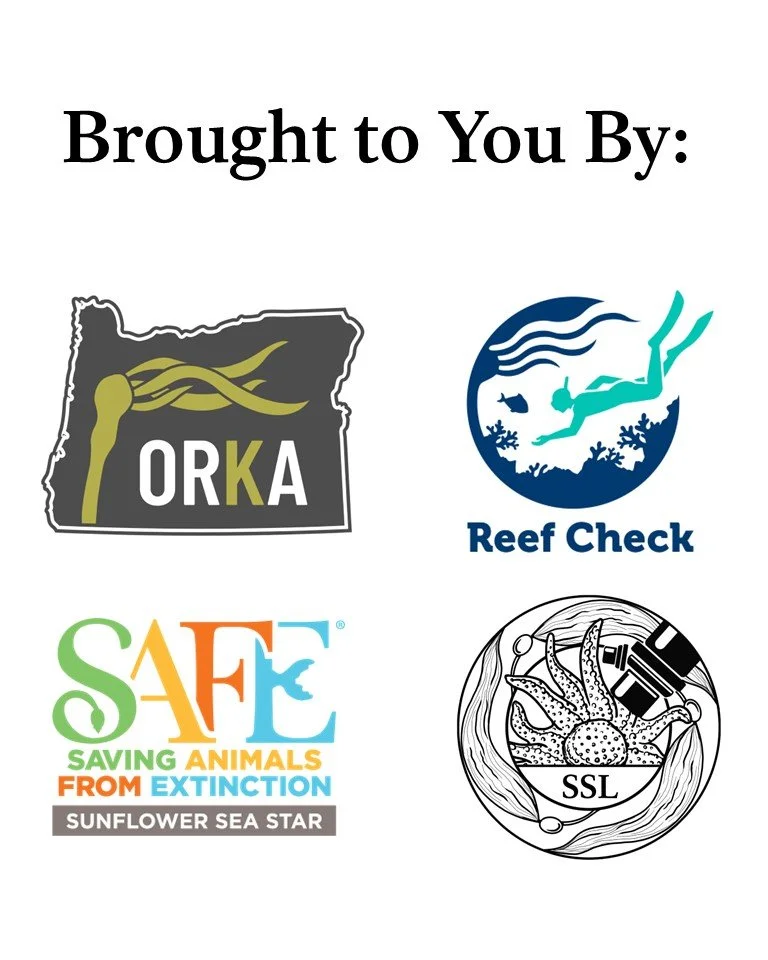Have You Seen a
Sunflower Star?
in California, Oregon, or Mexico
Reporting your sunflower star sighting provides researchers vital data about this critically-endangered species. By reporting a sighting below, you’re helping scientists better understand the extent of sunflower star recovery and the impacts of sea star wasting.
This form will mobilize immediate follow up efforts, but please ALSO help with long term data by reporting to iNaturalist.org
Why Sunflower Stars Matter
Sunflower stars are keystone predators who eat and scare kelp-munching species such as urchins, keeping them from overgrazing kelp forests. Their historic range extended from Alaska to Baja California.
In 2013-2014, a disease outbreak called Sea Star Wasting Syndrome devastated sunflower star populations, turning over 5 billion sunflower stars into goo and rendering their populations functionally extinct in the southern portion of
their range.
The absence of sunflower stars allowed urchin populations to proliferate and raze through kelp forests, turning them into urchin barrens. The loss of sunflower stars is one of the main reasons for the drastic decline in kelp forests in California and Oregon over the last decade.
Sunflower Star Search Prep List
Want to join the search for the critically-endangered sunflower star? Make sure you’re ready to go with this list!
-
A picture speaks a thousand words! We want to see as much recorded evidence as you can give us.
Shot list:
1. Take the first pic or video you can to get something on the record;
2. A photo or video to help with sizing - put something of a recognizable size in the frame like a human hand, a dive light or if you’re tidepooling, a coin, credit card, or hat;
3. A photo or video of the wider context (even if the sunflower star isn’t in frame). For example, we’d love to see the type of terrain, an urchin stampede running from their feared predator, the size and location relative to the ocean of tide pool, or what the surf and sun are up to.
4. Video (or photos) of the sunflower star’s behavior even if it’s just sitting there being awesome.
5. Some hero shots that you will hopefully give us permission to use. We want to spread the word of cool finds or just have more photos in our library. You can specify if you want photo credit.
-
We like to measure from the center of the body disc to the end of the most stretched out arm. Sunflower stars can squish and stretch like 24-armed contortionists, so this will be an inexact science.
A piece of flexible measuring tape that can be submerged is ideal. However, you can use anything you can later measure. The distance from your wrist to the tip of your middle finger is a great unit of measure in a pinch, just measure that distance with a ruler later.
-
GPS coordinates of your sighting would be excellent. You can get these by looking at the metadata of most images taken with a smartphone. A lot of cameras also have a location tracking function, but it may need to be turned on ahead of time. You can also drop a pin in your navigation app on your phone.
If you’re diving, try to grab the GPS location of where you dropped and/or a really detailed description of where you were within the dive site.
-
Look at your dive computer once you’re done getting the photo/video evidence. These metrics will help paint the picture of what’s happening.
-
We’re definitely going to ask you the date and time of your sighting, so best be prepared with a watch or dive computer or phone.
-
Try your best to remember:
Where you spotted the star - the general name of the location, how to access the site, and how you navigated to the star
The surrounding area - anything interesting we might want to know, such as the tide, the temperature, the visibility, the terrain and substrate (rock reef, sand, kelp forest, urchin barren, etc.)
Whether it looked healthy or showed signs of wasting disease (sores/leasions on any part of the body or looking like a partially deflated balloon)
What the sunflower star was doing while you watched it
What other nearby animals (such as urchins) were doing while you observed
-
If you’re diving, please obey safe diving practices. Plan your dive and bring everythng you need to conduct it safely.
If you’re tidepooling make sure you have appropriate footwear, a good way to get help if needed, sun protection, and plenty of water as well as any other tools you think you’ll need.
Did Your Sunflower Star Search Come Up Empty?
Data about the absence of sunflower stars is important to researchers too! You can use this form to report when you searched for sunflower stars, but didn’t find any.



